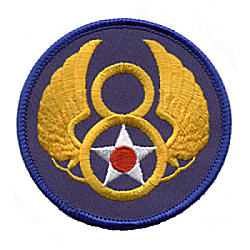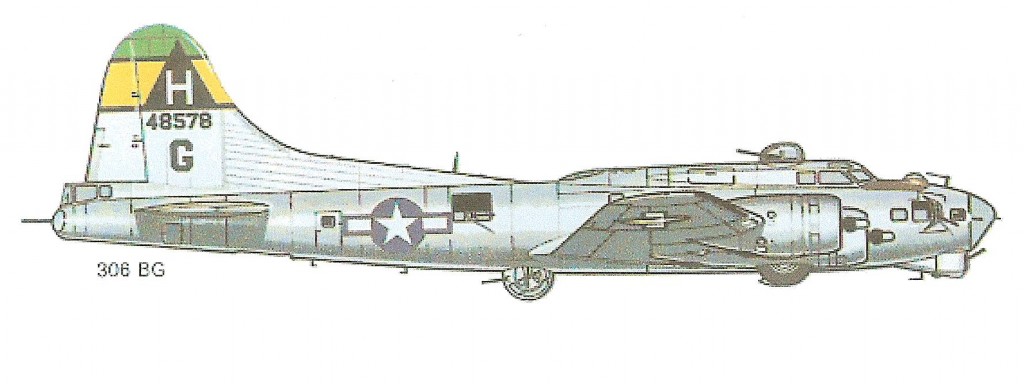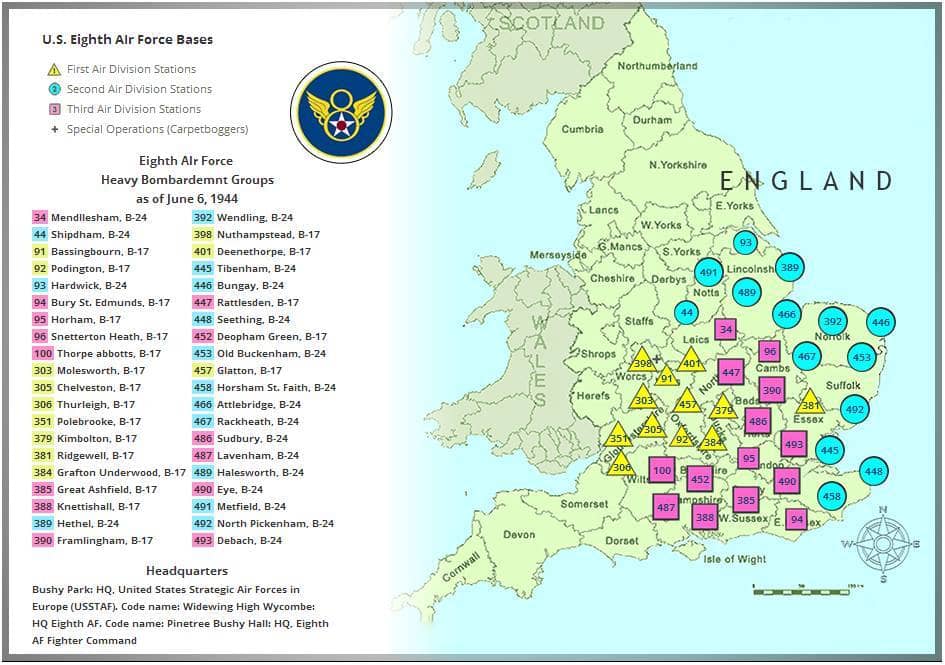
8th AF Shoulder Patch
The Eighth Bomber Command (re-designated the 8th Air Force in February 1944) was activated as part of the United States Army Air Forces on January 28, 1942, at Hunter Field in Savannah, Georgia.
The following month, Brigadier General Ira C. Eaker took the headquarters to England to prepare for aerial bombardment missions against Nazi-occupied Europe. The 8th AF became the greatest air armada in history, and by mid-1944 it reached a total strength of more than 200,000 people.
About 350,000 people served in the 8th AF during the war, and at its peak, it could dispatch more than 2,000 four-engine bombers and 1,000 fighters on a single mission. For these reasons, the 8th AF became known as the “Mighty Eighth”. The Mighty Eighth compiled an impressive record during World War II, however, this achievement carried a high price as the 8th AF suffered one-half of the U.S. Army Air Forces’ casualties in World War II; 47,000-plus casualties with more than 26,000 deaths (more deaths than in the entire Marine Corps)
The 8th AF was comprised of three Air Divisions (1st, 2nd, 3rd) with each having four Combat Wings. Within each Combat Wing were three Bomb Groups and within each Bomb Group were three to four Bomb Squadrons.
For example, the B-17 Susan Ruth crew was in the 369th Squadron of the 306th Bomb Group based at Thurleigh, England which was part of the 40th Combat Wing under the 1st Air Division. The other squadrons of the 306th BG based at Thurleigh, England were the 367th, 368th, and 423rd.
Every bomber had markings on the tail of the plane which identified it. For example, the tail markings on the B-17 Susan Ruth were a Triangle denoting the 1st Air Division, a yellow strip denoting the 40th Combat Wing, an H within the Triangle denoting the 306th Bomb Group, and a green stripe on top denoting the 369th Squadron. In addition, each plane had its own specific number which for the B-17 Susan Ruth was 43199.
The map below indicates all the the 8th Air Force Bomb Groups stationed in England during the war. Note: the placement of the Bomb Groups on the map does not accurately indicate their actual locations in England.


My dad was crew chief to the Steady Hedy one of 3 percent of planes to fly more than 25 missions over Germany. My dad’s plane flew 138 mission and was never returned for mechanical failure. I have pictures of him and his plane where he was stationed in Thurleigh England. I was there standing on the Turmac where his plane sat when we returned 40 years after the end of the war with him at my side. He was 8th Air Force 306th bomb group 369th squadron Fightin Bitin unit. He was one of the founding members of the 8th Air Force Historical society founded at the Marco Polo Hotel in Miami FL IN 1975. If you have any information about him and his plane I would appreciate a response. His plane was salvaged not scrapped due to damage suffered in 1945 0n a reconnisence mission. His name was Earl Schwab. Thank you for your time and consideration
Thank you for your comment. I have responded to you in an email. If you don’t see it, check your spam/junk folder. Steve
Hi Earl-
My grandfather Erwin “Tank” Keepman, Jr. was bombardier on the Steady Hedy. He was stationed in Thurleigh as part of the 306th Bombardment Group (H).
That is interesting that the plane was salvaged–would you have any idea where or if it resides anywhere today?
Hi Matt. Here is information about :Steady Hedy”. Please join the 306th Bomb Group Historical Association. It’s free, and you can find information about your grandfather by using the Search Option. https://www.306bg.us/ Are you on Facebook? If you are interested, please check out my book SHOT DOWN which is centered around the 306th Bomb Group. On Amazon at http://bit.ly/ShotDownBook Thank you for your consideration. Take care and God bless.
Thank you for this Steve–appreciate it. I’ll check out the Facebook Page.
My dad as a pilot flew out of glatton, he was one of the 220 who received the DFC. His B-17 was named the “rampant pansy”, during his life (died in 2000) he never gave me a good description why he received the honor. I am of the understanding that all the service records of that period were lost in a fire, do you know about any of that? He was 26 at the time and the rest of the crew called him the old man…..he didn’t lose any of the crew and they all made it home.
They were The Greatest Generation! What was your dad’s name? Do you know what bomb group he was in?
I tried somewhat unsuccessfully to tease stories out of my dad about his WWII military service for 35 years. His records were destroyed in the St Louis fire. As a result my information is sketchy. He was in Eighth Air Force. I have a picture of a group review of B-17s Great Falls, Montana (documented: G-/83-401) (21-7-43). From his Enlisted Record and Report of Separation I can glean: his occupation was Ap Armorer 911; he qualified for carbine and SMG cal 45; attended service schools at Bickley and Lowry. His arrival ETO was 2 Nov 43. He was based in England for 7 months (doing what I don’t know – thinking western England – he did have a girlfriend from Wales) until he landed in Normandy D+4. He has a EAME Ribbon w/7 Battle Stars and Dist Unit Badge (Northern France, Southern France, C Europe, Rhineland, Ardennes, Normandy, Air Offensive Europe). He received an honorable discharge as a Sgt. Towards in end of his life I returned with him to Normandy in 1998. I just listened to snippets of stories (he called them flashbacks) rather than peppering him with the questions I had. My lingering question is how does an 18-year old kid from Jersey inducted into the Army Air Corp assigned to and trained by the 8th Air Force (Sq S 233rd AAF BU) end up turning 20 on the Beaches of Normandy and spend the next year in combat on the ground moving across France before getting injured shortly after crossing the Rhine? Is this a one off of a kid that got busted and sent to fight with the infantry or was there systematic reassignment of some as military needs and priorities shifted? Any informed insight?
Hi Jerry. What was your dad’s name?
Stanley Howard Kaufman
https://www.americanairmuseum.com/archive/person/stanley-kaufman
Stanley Howard Kaufman
The Greatest Generation! https://www.americanairmuseum.com/archive/unit/479th-fighter-group
Your dot com site is a great find for me, thank you for the map and information.
I was looking to see how many Groups in the 8th, and now know that Divisions and Wings were higher headquarters.
I am reading a 1997 book titled, The Mighty Eighth by Gerald Astor. It was in a library book sale and appeared to have NEVER been opened.
Thank you very much, Richard. That is a great book and includes some of the story of my dad and his crew. If you are interested in reading the complete story and learning more about the 8th Air Force and the air war over Europe, please check out my book SHOT DOWN. On Amazon at http://bit.ly/ShotDownBook
It is our duty to remember.
Both my Uncle, SSgt. Howard Schwegel and my father, Cpl. Elmer F.Schwegel were stationed in England at the same time during the war and neither of them knew that his brother was stationed there also.
They were born a year apart and they looked so much alike they were often thought to be twins, and dad said that his older brother was also his best friend.
Howard enlisted shortly after Pearl Harbor and my father enlisted a year later after working on the design of the dual strut landing gear for the C-47 (DC-3) at Wright Patterson AFB.
Howard was a B-24 waist gunner and was in the 856th bomb squadron, 492nd BG out of North Pickenham, Norfolk. He, along with all his fellow crew members were killed on the 4th of June, 1944, 2 days before D-Day when his B-24, piloted by Lt. Sachtleben crashed during assembly on a bomb run to Avord, France.
My father did not know of his brothers death until he received a letter from my grandfather informing him of his death and the details. His brothers death haunted dad for the rest of his life
My father was in a photo reconnaissance squadron somewhere in England at the time.
My dad’s records were also destroyed in the St. Louis records fire so I only know a little about his service from his DD-214.
He would never discuss his war experiences and I only know of his service from his uniform and his DD-214 and from a box of aerial photos of Dresden and Berlin.
According to his DD-214 he received a Bronze Star and two oak leaf clusters and it states he was at “Ardennes”.
I have always wondered how he got a Bronze Star and was at the Ardennes while serving in the USAAC.
I have only respect for my father and my uncle, and they inspired my service in the USAF.
God bless them both! You are not forgotten!
Much appreciated, They were The Greatest Generation. It is our duty to remember.
What is the scale on this map? My father was a YB-40 and B-17 pilot with the 92nd BG when they were in Alconbury. Thank you for this reference!
Sorry, but I don’t really know. However, the driving distance between Alconbury and the 306th BG in Thurleigh is 20 miles. So even less as the crow flies. Most bases were only 5-10 miles apart.